Crucial v4 (256GB) Review
by Kristian Vättö on November 22, 2012 1:01 PM ESTAnandTech Storage Bench 2011
Last year we introduced our AnandTech Storage Bench, a suite of benchmarks that took traces of real OS/application usage and played them back in a repeatable manner. Anand assembled the traces out of frustration with the majority of what we have today in terms of SSD benchmarks.
Although the AnandTech Storage Bench tests did a good job of characterizing SSD performance, they weren't stressful enough. All of the tests performed less than 10GB of reads/writes and typically involved only 4GB of writes specifically. That's not even enough exceed the spare area on most SSDs. Most canned SSD benchmarks don't even come close to writing a single gigabyte of data, but that doesn't mean that simply writing 4GB is acceptable.
Originally we kept the benchmarks short enough that they wouldn't be a burden to run (~30 minutes) but long enough that they were representative of what a power user might do with their system. Later, however, we created what we refer to as the Mother of All SSD Benchmarks (MOASB). Rather than only writing 4GB of data to the drive, this benchmark writes 106.32GB. This represents the load you'd put on a drive after nearly two weeks of constant usage. And it takes a long time to run.
1) The MOASB, officially called AnandTech Storage Bench 2011—Heavy Workload, mainly focuses on the times when your I/O activity is the highest. There is a lot of downloading and application installing that happens during the course of this test. Our thinking was that it's during application installs, file copies, downloading, and multitasking with all of this that you can really notice performance differences between drives.
2) We tried to cover as many bases as possible with the software incorporated into this test. There's a lot of photo editing in Photoshop, HTML editing in Dreamweaver, web browsing, game playing/level loading (Starcraft II and WoW are both a part of the test), as well as general use stuff (application installing, virus scanning). We included a large amount of email downloading, document creation, and editing as well. To top it all off we even use Visual Studio 2008 to build Chromium during the test.
The test has 2,168,893 read operations and 1,783,447 write operations. The IO breakdown is as follows:
| AnandTech Storage Bench 2011—Heavy Workload IO Breakdown | ||||
| IO Size | % of Total | |||
| 4KB | 28% | |||
| 16KB | 10% | |||
| 32KB | 10% | |||
| 64KB | 4% | |||
Only 42% of all operations are sequential; the rest ranges from pseudo to fully random (with most falling in the pseudo-random category). Average queue depth is 4.625 IOs, with 59% of operations taking place in an IO queue of 1.
Many of you have asked for a better way to really characterize performance. Simply looking at IOPS doesn't really say much. As a result we're going to be presenting Storage Bench 2011 data in a slightly different way. We'll have performance represented as Average MB/s, with higher numbers being better. At the same time we'll be reporting how long the SSD was busy while running this test. These disk busy graphs will show you exactly how much time was shaved off by using a faster drive vs. a slower one during the course of this test. Finally, we will also break out performance into reads, writes, and combined. The reason we do this is to help balance out the fact that this test is unusually write intensive, which can often hide the benefits of a drive with good read performance.
There's also a new light workload for 2011. This is a far more reasonable, typical every day use case benchmark. It has lots of web browsing, photo editing (but with a greater focus on photo consumption), video playback, as well as some application installs and gaming. This test isn't nearly as write intensive as the MOASB but it's still multiple times more write intensive than what we were running last year.
We don't believe that these two benchmarks alone are enough to characterize the performance of a drive, but hopefully along with the rest of our tests they will help provide a better idea. The testbed for Storage Bench 2011 has changed as well. We're now using a Sandy Bridge platform with full 6Gbps support for these tests.
AnandTech Storage Bench 2011—Heavy Workload
We'll start out by looking at average data rate throughout our new heavy workload test:
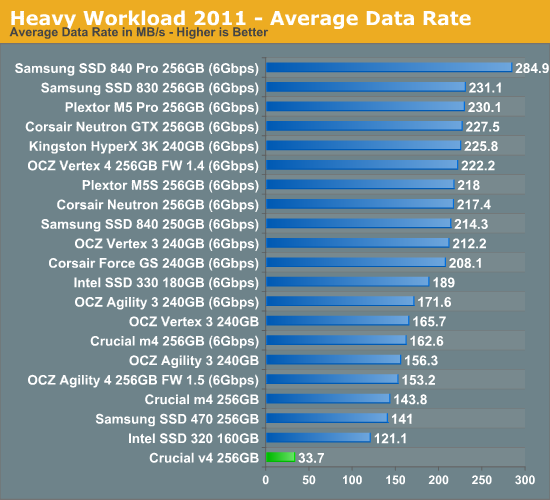
The poor random read/write speeds do have a significant impact on our Storage Suite scores as well. The v4 is the slowest SSD we have tested since the creation of the MOASB. To put this in perspective, it took over six hours for the Heavy suite to run, whereas it usually takes around an hour and a half. Any current SSD will be three to five times faster than the v4, even when operating at SATA 3Gbps speeds.
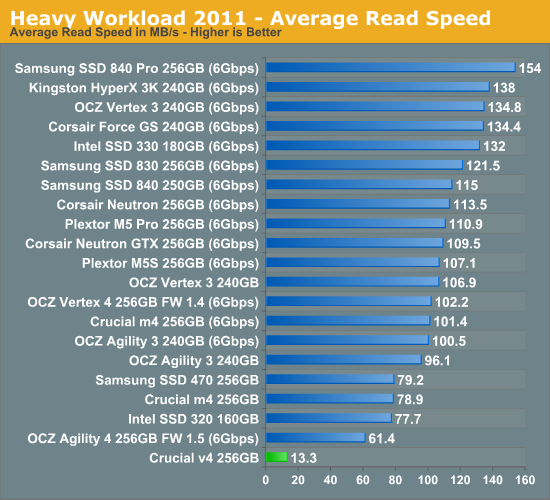
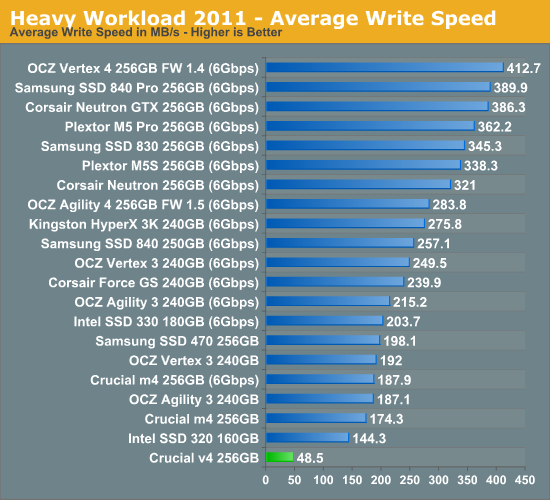
The next three charts just represent the same data, but in a different manner. Instead of looking at average data rate, we're looking at how long the disk was busy for during this entire test. Note that disk busy time excludes any and all idles; this is just how long the SSD was busy doing something:
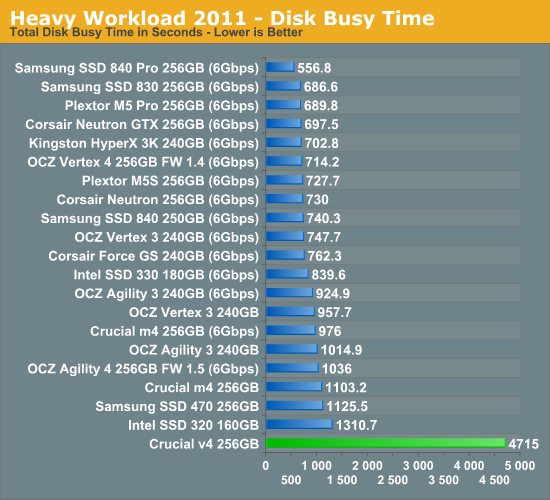
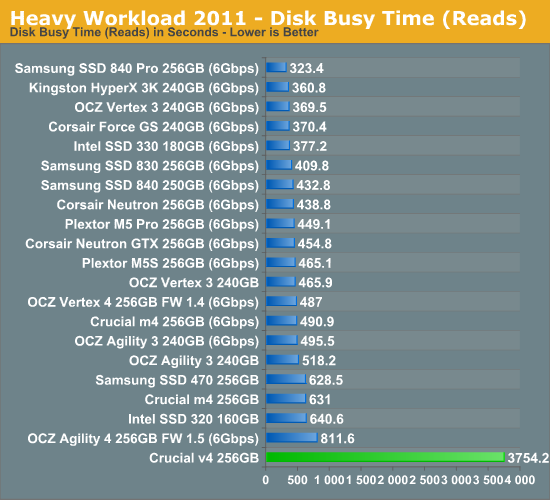
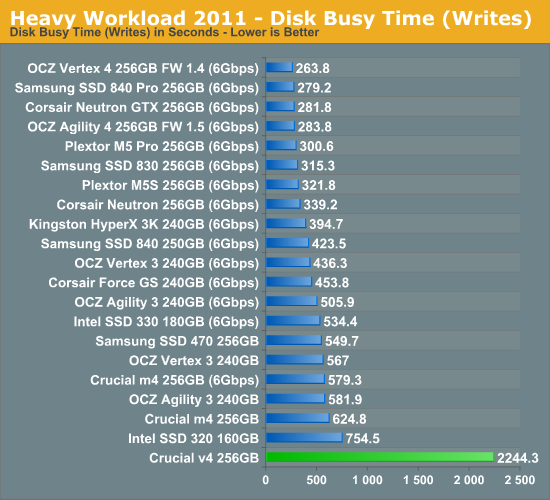










44 Comments
View All Comments
andrejg - Tuesday, November 27, 2012 - link
I thought the same until - I had two PC's of similar capacity with windows 8 side by side. One had Samsung SSD 830 256 and the other had Crucial v4 128.Difference was noticable, from start/boot to installations and other operations. They are both very good comparing to HDD, but Samsung rocks and Crucial is only faster than HDD.
supercoffee - Thursday, November 22, 2012 - link
I'm no expert, but I thought SSD read performance was generally always higher than write performance. If this is the case, then the average read and write speed charts on the Storage bench 2011 page are wrong and should be fixed. Thanks.Kristian Vättö - Friday, November 23, 2012 - link
When you read data, you have to fetch it from the actual NAND. When writing, you can first cache the data and write it to NAND at a later date (works well with small IOs as they can then be combined to increase throughput). Writing to a cache is extremely fast and hence write speeds are often higher.Sequential read speed at bigger IO sizes is definitely higher, but most of the actual usage IOs are somewhat random and small in size. Big sequential IOs are easy to read because you get the benefit of multiple dies but the smaller the IO and queue depth, the less interleaving can be done. For example, 4KB random read at QD1 is often limited by NAND bandwidth because you can only read from one NAND die at the time, which isn't all that fast.
iwod - Thursday, November 22, 2012 - link
I mean the majority of cost for SSD goes to the NAND, there is no point trying to save a dollar or two and offer such inferior product, Those who are going to spend $100 and buy comparatively expensive HDD replacement would not have cared about the $10 dollars difference if it offer something like 5x less performance.Those who only owns a SATA 1 / 2 Port would have wanted a much faster SSD now for so they could get faster performance if they upgraded their MB.
So in reality this strange line of product is aiming squarely at those who have absolutely no clue about SSD performance or OEMs builders who could simply rip more off from customers.
The only niche i think this fits in are PATA, UATA port, where old computers could immensely benefits from SSD.
kmmatney - Friday, November 23, 2012 - link
What this review is sorely lacking is any sort of real-life experience with the drive. Does it still "feel" like an SSD in actual use? Does windows boot up fast? I'd buy a lower performing Crucial SSD over a faster OCZ drive, as long as itis "fast enough".toine_r - Saturday, November 24, 2012 - link
Unfortunately, I bought one (the 128Gb version) before this article has been published (17-11-2012).I strongly suggest buying another "real" SSD, because this one is not fast enough for day to day use, even for replacing a HDD.
I replaced a 5400rpm HDD with it on a netbook running Ubuntu, and the SDD was slower than the HDD for some operations (typically, installing packages and applications took hours on the SSD).
Experience on windows may be better, but its probably safer to buy another one.
Dustin Sklavos - Friday, November 23, 2012 - link
I love Crucial's stuff and would easily recommend the m4 personally, but...This has to be one of the worst products we've reviewed all year. I'm kind of in awe of how terrible it really is, the only way you could justify it compared to what else is available is to sell it at half the cost of any other SSD with comparable capacity.
cjs150 - Friday, November 23, 2012 - link
Great response Dustin - I only which I had written it.KAlmquist - Saturday, November 24, 2012 - link
With a metal case (instead of plastic) and synchronous NAND (instead of asynchronous) it's like Crucial wasn't even trying to hit a price point where an SSD with the Phison controller would make sense.Impulses - Wednesday, November 28, 2012 - link
As brutal as the review was, it was still too kind! The first budget SSD that one of the major players put out (Intel's X25-V) still manages random read/write performance that's about 3x faster! Granted that drive had abysmal sequential writes (as bad as a bad 5,400 drive), but it'd still make a better OS drive (provided you could live with 40GB!).